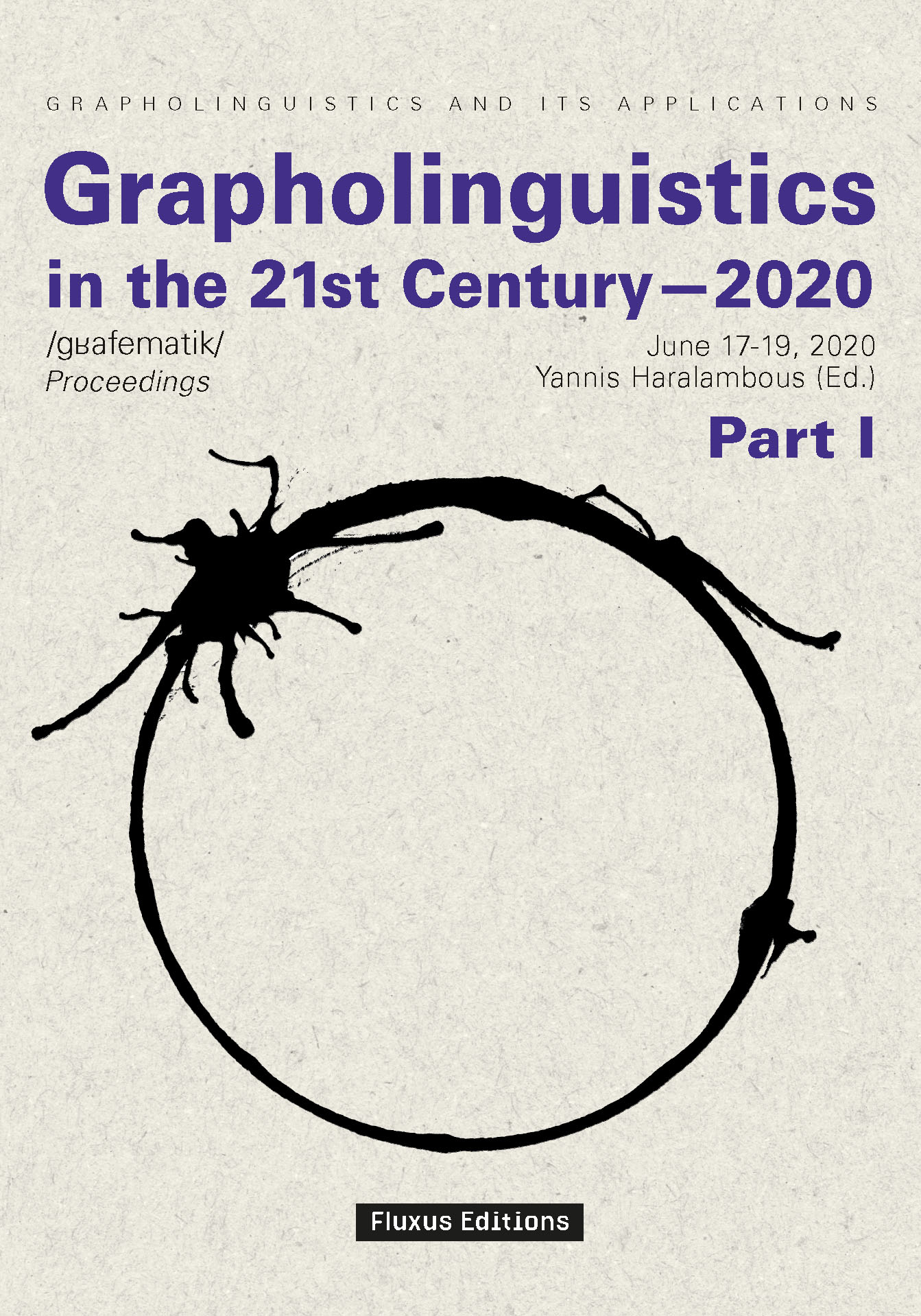
 ISSN: 2534-5192 (electronic) – 2681-8566 (print)
ISSN: 2534-5192 (electronic) – 2681-8566 (print)
 ISSN: 2534-5192 (electronic) – 2681-8566 (print)
ISSN: 2534-5192 (electronic) – 2681-8566 (print)| ◀ Y. Neuman | ▲ Proceedings | T. S. Melka & R. M. Schoch ▶ |
 ISBN: 978-2-9570549-6-1 e-ISBN: 978-2-9570549-8-5  | Emojis Are Everywhere. How Emojis Conquer New Contexts Christa Dürscheid  Abstract. This article first presents facts and figures about emoji use, which, as is pointed out, is by no means restricted to private everyday communication (Section 1). Next, two studies are discussed, shedding light on the following questions: on the one hand, whether emojis are indeed preferred by younger people and, on the other, which impression the use of specific emojis with positive or negative connotations leaves with the addressee of text messages (Section 2). The heart of this essay follows in Section 3—it focuses on emoji use during the COVID-19 crisis (which, at the time of writing, is still ongoing). Here, observations concerning new forms of emoji use on Facebook and in types of video chat (such as Zoom and Skype) are collected. Among these, two are discussed in more detail: firstly, the possibility to react to Facebook posts with a hugging face, which is supposed to help users take a symbolical stance “against loneliness.” Secondly, the fact that in video chats, emojis can now be sent as so-called real time reactions. This way, it is possible, for example, to send a thumbs down sign emoji while another person is speaking. In Section 4, an outlook is given, raising the question of how emoji use can be described at a linguistic level now that, given this new development in video chats, emojis are used also in oral communication and thereby cease to be mere complements to or substitutes for writing. DOI: https://doi.org/10.36824/2020-graf-duer
@ARTICLE{aretz2019a,
AUTHOR = {Aretz, Wera},
TITLE = {Zeige mir Deine Emojis und ich sage Dir, wie Du bist: Die Nutzung und Wirkung von Emojis in der privaten Kommunikation},
JOURNAL = {Journal of Business and Media Psychology},
YEAR = {2019},
VOLUME = {10},
NUMBER = {1},
PAGES = {37--42},
}
@ARTICLE{beisswenger2019a,
AUTHOR = {Beißwenger, Michael and Pappert, Steffen},
TITLE = {How to Be Polite with Emojis: a Pragmatic Analysis of Face Work Strategies in an Online Learning Environment},
JOURNAL = {European Journal of Applied Linguistics},
YEAR = {2019},
VOLUME = {7},
NUMBER = {2},
PAGES = {225--253},
}
@INPROCEEDINGS{tv,
AUTHOR = {Dürscheid, Christa},
TITLE = {Emojis sind überall. Schreiben in digitalen Zeiten},
BOOKTITLE = {Medien in Krisenzeiten},
SERIES = {tv diskurs},
YEAR = {2020},
VOLUME = {93},
NUMBER = {3},
PAGES = {62--65},
URL = {https://tvdiskurs.de/data/hefte/ausgabe/93/duerscheid-emojis-tvd93.pdf},
}
@BOOK{duerscheid2016b,
AUTHOR = {Dürscheid, Christa and Frick, Karina},
TITLE = {Schreiben digital. Wie das Internet unsere Alltagskommunikation verändert},
PUBLISHER = {Kröner},
ADDRESS = {Stuttgart},
YEAR = {2016},
}
@INPROCEEDINGS{duerscheid2019a,
AUTHOR = {Dürscheid, Christa and Meletis, Dimitrios},
EDITOR = {Haralambous, Yannis},
TITLE = {Emojis: A Grapholinguistic Approach},
BOOKTITLE = {Graphemics in the 21st Century},
SERIES = {Grapholinguistics and Its Applications},
PUBLISHER = {Fluxus Edition},
ADDRESS = {Brest},
YEAR = {2019},
VOLUME = {1},
PAGES = {167--183},
}
@INPROCEEDINGS{herring2017a,
AUTHOR = {Herring, Susan C. and Dainas, Ashley R.},
TITLE = {“Nice picture comment!” Graphicons in Facebook Comment Threads},
BOOKTITLE = {Proceedings of the Fiftieth Hawai'i International Conference on System Sciences (HICSS-50)},
PUBLISHER = {IEEE},
ADDRESS = {Los Alamitos, CA},
YEAR = {2017},
URL = {https://ella.sice.indiana.edu/~herring/hicss.graphicons.pdf},
}
@TECHREPORT{jim-study,
AUTHOR = {{Medienpädagogischer Forschungsverbund Südwest}},
TITLE = {Jugend, Information, Medien. Basisuntersuchung zum Medienumgang 12- bis 19-Jähriger},
YEAR = {2019},
URL = {https://www.mpfs.de/fileadmin/files/Studien/JIM/2019/JIM_2019.pdf},
}
@BOOK{seargeant2019a,
AUTHOR = {Seargeant, Philip},
TITLE = {The Emoji Revolution: How Technology is Shaping the Future of Communication},
PUBLISHER = {Cambridge University Press},
ADDRESS = {Cambridge},
YEAR = {2019},
}
@UNPUBLISHED{tschernig2015a,
AUTHOR = {Tschernig, Kristin and von Hertzberg, Katharina},
TITLE = {Altersgruppenspezifisches Nutzungsverhalten von Bildzeichen bei WhatsApp},
YEAR = {2015},
URL = {http://www.mediensprache.net/de/websprache/messaging/whatsapp/icons/index.asp},
}
Christa Dürscheid (2020), “Emojis Are Everywhere. How Emojis Conquer New Contexts,” in Proceedings of Grapholinguistics in the 21st Century, 2020 (Yannis Haralambous, Ed.), Grapholinguistics and Its Applications, Vol. 4, Brest: Fluxus Editions, 501–512.
@INPROCEEDINGS{gla4-duer,
AUTHOR = {Christa Dürscheid},
EDITOR = {Haralambous, Yannis},
TITLE = {{Emojis Are Everywhere. How Emojis Conquer New Contexts}},
BOOKTITLE = {{Proceedings of Grapholinguistics in the 21st Century, 2020}},
SERIES = {{Grapholinguistics and Its Applications}},
VOLUME = {4},
PUBLISHER = {Fluxus Editions},
ADDRESS = {Brest},
YEAR = {2020},
PAGES = {501--512},
DOI = {https://doi.org/10.36824/2020-graf-duer},
}
|